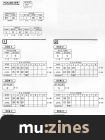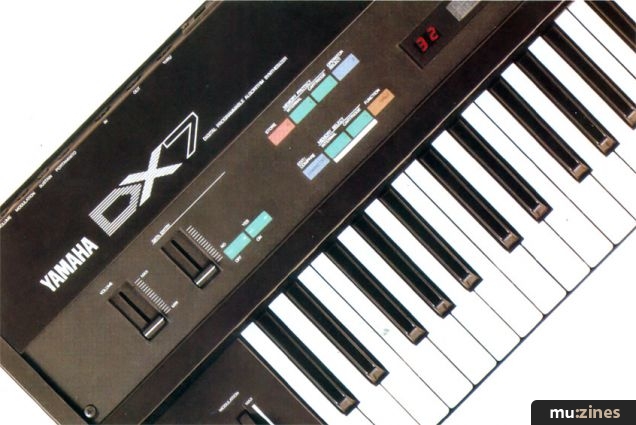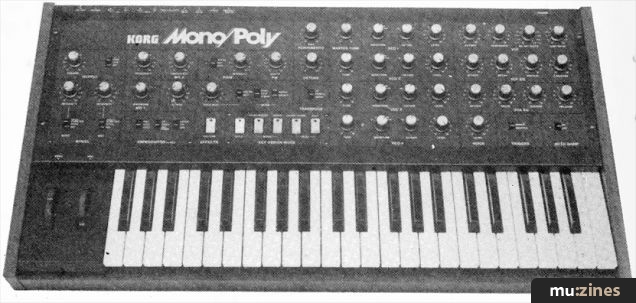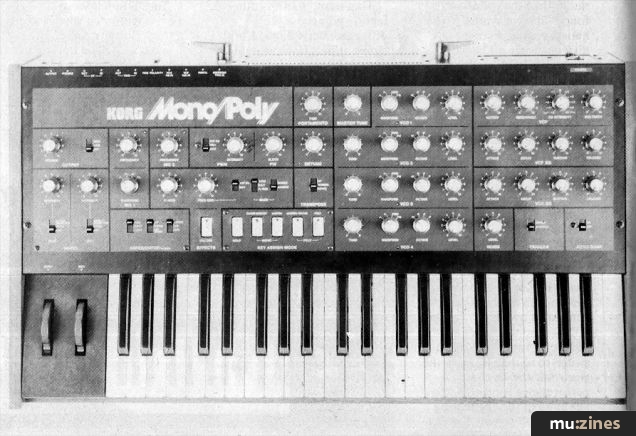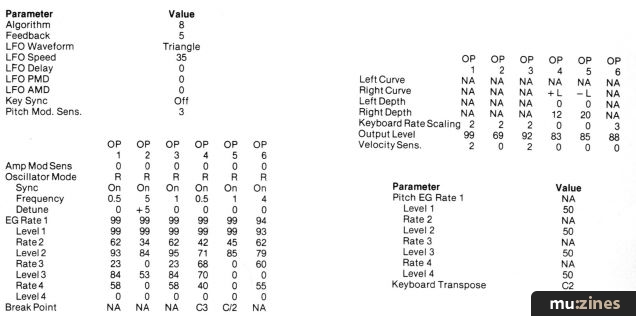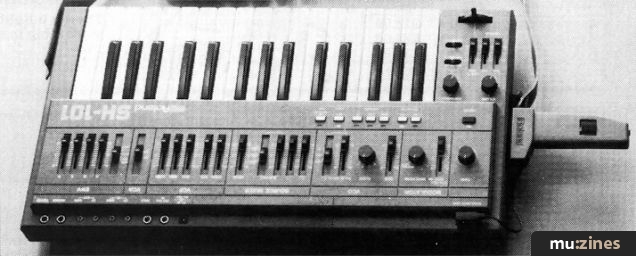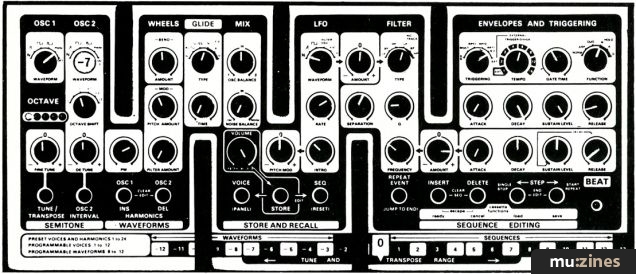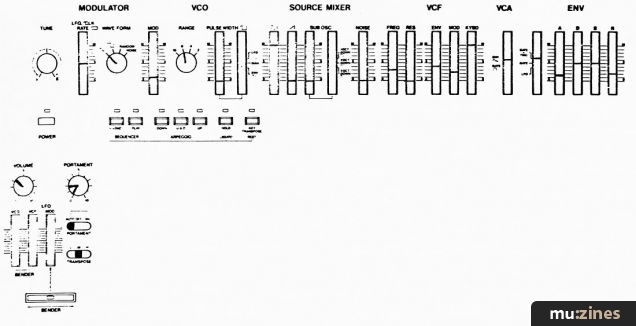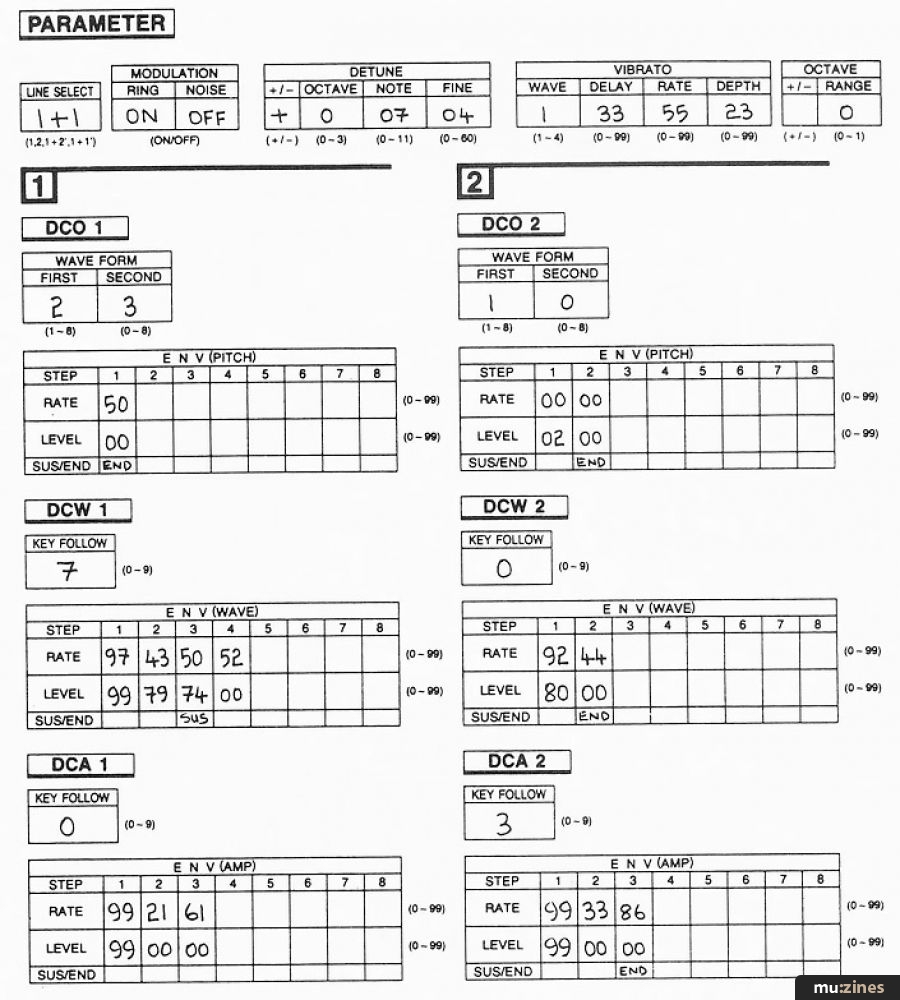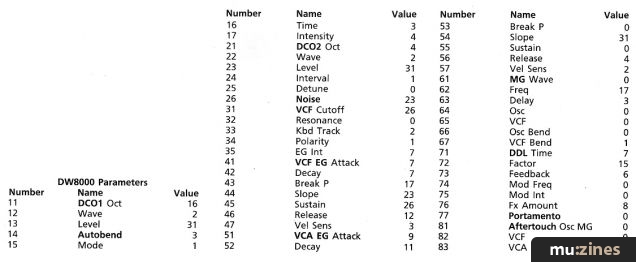Magazine Archive
Home -> Magazines -> Issues -> Articles in this issue -> View
Patchwork | |
Article from Music Technology, December 1986 | |
The readers' synth sound page goes from strength to strength, with the Yamaha DX7, Korg Mono/Poly, Sequential Pro-One and Casio CZ101 among the featured instruments. Plus a review of a DX7 ROM that contains 512 sounds.
Now that Patchwork is bigger than ever, you've an even better chance of seeing your favourite sound in print, not to mention your favourite magazine on your doorstep free of charge. And if you're still waiting to see your particular synth featured in these pages, why not be the first to submit some sounds?
Many readers are now supplementing their patch charts with a short demo cassette of the sounds in question, and this is really good news for our overworked (and generally hungover) editorial team. Don't worry too much about classic performances and impeccable recording quality; just present your sounds simply and concisely - and convince us you're the best of the bunch.
Don't forget that if your patch gets published, you'll receive a free year's subscription to MUSIC TECHNOLOGY with our compliments. So send us your favourite sounds on a photocopy of an owner's manual chart (coupled with a blank one for artwork purposes) accompanied, if possible, by a short demo-tape. Include a decent-length description of your sound and its musical purpose in life, and write your full name and address on each chart. And remember, edited presets are all very well, but an original masterpiece is always preferable. OK?
ROLAND ALPHA JUNO 2 - Harmonica
Ian Chisholm, Cleveland
The first airing for one of the new Roland Junos, and about time too. Let's hear from some other proud Alpha owners soon.
A good Harmonica patch may not be an essential in every programmer's sound armoury, but Ian thought it was worth try ing to improve on the Juno 2 s preset offering. Can you do better?

(Click image for higher resolution version)
YAMAHA DX7 - Timefluss
Roberto Laneri, Italy
From a selection of patches by Roberto, we chose a lovely, flutey brass sound that encourages you to make good use of the DX7's velocity-sensitivity; harder key strikes introduce a muted brass element and a prominent modulation effect. Given an impressive hi-tech setup which includes a DX7 plus four TX7s, you should find plenty of other good FM sounds on Roberto's record, 'Two Views of the Amazon' (Wergo SM1046). A review may follow if a copy finds its way to the Music Editor...

(Click image for higher resolution version)
SCI PRO-ONE - Pro-Clunk
Steve Byhurst, Surrey

The new, extended Patchwork allows for the inclusion of patches for some older synths. and 'Pro-Clunk' should confirm that there's life in the old monosynths yet... As you may have guessed, this is a clunky type of sound: one oscillator provides the low bass part while the other supplies the higher portion.
'Pro-Clunk' is useful for sequencing work, especially as a bass part, but can also double as a solo sound using the LFO for adding vibrato via the mod wheel (preferably with some deep reverb added). But this is a versatile sound, and Steve suggests changing the cutoff frequency to make it more brassy or brighter. Experimenting with the Filter EG controls can also provide some interesting, if not always very usable, results.

(Click image for higher resolution version)
KORG MONO/POLY - Trivial Percussion
Adrian Bennet, Northumberland

(Click image for higher resolution version)
It's a long time since the Mono/Poly got a look in these pages, but we couldn't resist this oddball selection of bell md percussion sounds. Our favourite was 'Bamboo Chimes', but even the more obscure sounds have some musical use. Adrian waxes lyrical over them as follows:
Scaffolding - is a hollow metallic clunk which sounds exactly like builders throwing scaffolding onto the back of a wagon.
Knackered Tubular Bells - are quite realistic, but with something rather unsettling about their harmonic content. They sound even better through a stereo chorus unit.
Talking Milk Bottles - milk bottles used as pan pipes: a breathy puff to start with, followed by a hollow reverberation which continues for a moment after you stop blowing.
Soprano & Bass Woodblocks - very realistic and with many musical uses.
Bronze Bell - is a large and very realistic reverberating bell, and again it sounds good with stereo chorus.
Twanging Rubber Band - starts with a nasty buzzing twang which gives way to a short rubbery note that quickly (and mercifully) dies away.
Bamboo Chimes - the initial clunk of wood striking bamboo, followed by a rich, hollow reverberation.
Tea Cup - a teaspoon strikes Auntie's best china...
BIT ONE - Bit for a King
Marcus King, Wilts
Who fancies a Bit then? Quite a few of you, if the amount of patches we receive are anything to go by. Marcus has sent us four of his faves for the Bit One, and describes them as:
Filter Sweep (A) - a very "synthetic" voice with a long release time, useful for block chords.
Expansion (B) - an atmospheric sound with long attack and release. It should be played staccato, allowing the sound to expand in the same way as the similarly named voice on the DX7.
DX Strings (C) - are best used for playing string quartet-style parts; played sympathetically, it can sound surprisingly realistic.
Croc Rock Organ (D) - is a gutsy, slightly distorted-sounding organ, modelled on the one used on Elton John's 'Crocodile Rock', hence the title.

(Click image for higher resolution version)
CASIO CZ101 - Rich Reward
Jacek Grudzien, London SW18

Although received devoid of any descriptive prose, 'Rich Reward' turned out to be a good, fat sound for the CZ that should find its way into a good many solo meanderings. Jacek, incidentally, is a young Polish composer currently on a music scholarship in London, and his sound's inclusion in Patchwork has absolutely nothing to do with the Editor's ancestors being Polish. Honest.

(Click image for higher resolution version)
Available files:
 Rich Reward.syx.zip (658 B)
Rich Reward.syx.zip (658 B)
Single patch for CZ series
ben@muzines | 5th Dec 2019 | Downloads: 99
Arturia CZ-V patch
ben@muzines | 6th Dec 2019 | Downloads: 107
 VCZ Rich Reward.aupreset.zip (3 KB)
VCZ Rich Reward.aupreset.zip (3 KB)
Virtual CZ aupreset
ben@muzines | 5th Dec 2019 | Downloads: 89
Virtual CZ VST3 preset
ben@muzines | 5th Dec 2019 | Downloads: 91
Monst-ROM 512
ROM cartridge for Yamaha DX7
Price £145 including VAT
IT SEEMS FAINTLY absurd that over 500 synthesiser sounds can come from a plastic cartridge measuring no more than three inches by two. Yet in this age of continuing miniaturisation, it should come as no surprise to learn that a West German company has succeeded in squeezing that many sounds onto a ROM cartridge identical in external spec to Yamaha's original DX7 design.
The ROM in question carries the unpromising title of Monst-ROM. and two switches protrude through its casing out of the printed circuit board that lies within. One of these selects the bank you're using, the other the group; since an unmodified DX7 can cope with banks of no more than 32 sounds at a time, the Monst-ROM's voices are divided into four groups, with each group possessing four banks. That's 16 banks and 512 sounds in total, so you can put the calculator away.
Now, lest you start to feel sympathy for the engineers who had to program these sounds, I ought to point out that, according to UK importers Executive Audio, they were "created by advanced computerised resynthesis techniques". Whether this means the Monst-ROM voices are the result of a software program like Steinberg's ProCreator (reviewed elsewhere this issue) isn't clear, but I know I wouldn't like the idea of having to program 512 DX voices, so the computer has obviously earned its keep.
Each of the 16 banks on Monst-ROM represents a family (sometimes two families) of sound, so that, for instance, bank A1 consists mainly of piano sounds, A2 deals with human voices, D1 houses studio sound effects, and D2 plays host to a variety of bass sounds.
But the first thing you learn about Monst-ROM is that the names its patches have been given aren't necessarily a very good guide to what they're going to sound like. This is bad enough with voices such as "Trumpet 1" and so on, but a real pain when you're faced with sounds called "Moog Mini", "Kurzweil 1" and "CS80", which do almost precisely the opposite of what you expect them to do.
The worst offender here is bank C2, whose patches are named simply "Synth 1" to "Synth 32" inclusive, despite the fact that none of them really sound like synthesisers at all. Then again, there are some who'd argue that sounding like a synthesiser is not a DX7 forte in any case...
But to more serious matters, and the vexed question of whether the bulk of the voices on Monst-ROM really sound any good - regardless of what they're called. Well, I have to report that the standard of sounds on this ROM is sickeningly high. There are the usual DX let-downs like weedy analogue leadline imitations and wayward bass crunches, but in the main, the Monst-ROM's sounds pack a hell of a punch.
Among the most realistic are the organs (acoustic and electric, but especially the Hammonds), the electric pianos (we're used to great Rhodes rip-offs, but it's the Wurlitzers that stand out here), some marvellously "chiffy" flutes and panflutes (including one called "Zhamfir"), and the usual complement of sparkling bells, vibes, marimbas and xylophones, some of which are refreshingly distinctive.
Moving away from realism and onto less likely programs, there are some fine vocal approximations lurking under the guise of "PPG" patches, a fair sprinkling of "dreamy" slow-attack synth sounds (just right for ambient washes), and some novel combination sounds, the most successful of which is the striking "Bell/Str". If I had to pick a favourite from the 512 (it was a long night), this hybrid of a hollow, rounded bell tone and silky (and unexpectedly "analogue") strings would be the one.
£145 may seem a lot to pay for a collection of synthesiser sounds, but set against the cost of a DX7, it seems incredibly little. The Monst-ROM is a vast library of useful sounds that could come into their own in any number of recording situations, even if those switches could be a bit fiddly to use live.
And if, on hearing this astonishing selection, you decide to have a bash at programming your DX yourself, I can't think of a better place to find source patches than the Monst-ROM; imagine tweaking this little lot.
More from (Contact Details)
More with this topic
Patchwork |
Patchwork |
Patchwork |
One For The 7 - DX7 Patch |
Load Baring |
Special FX |
Patchwork |
Patches |
Patchwork |
Patchwork |
Patches |
Patchwork |
Browse by Topic:
Synthesizer Patches
Also featuring gear in this article
BeeBMIDI (Part 3)
(EMM Aug 84)
BeeBMIDI (Part 7)
(EMM Mar 85)
Bit One - Synthcheck
(IM Jan 85)
Casio CZ-101 - Professional Polyphonic Synth
(IT Jan 85)
Casio CZ101
(12T Jan 85)
Casio CZ101 - Synthcheck
(IM Feb 85)
Chase Bit One - Programmable Polysynth
(EMM Nov 84)
Crumar Bit One
(12T Dec 84)
Digital Dynamite
(ES Jan 85)
Hands On: Yamaha DX7
(SOS Dec 92)
How They Do Only You
(12T Nov 82)
Korg Mono/Poly
(EMM Apr 82)
Lead On
(ES Mar 84)
Patchwork
(EMM Feb 84)
Patchwork
(EMM Mar 84)
Patchwork
(EMM Apr 84)
Patchwork
(EMM May 84)
Patchwork
(EMM Jul 84)
Patchwork
(EMM Aug 84)
Patchwork
(EMM Oct 84)
Patchwork
(EMM Jan 85)
Patchwork
(EMM Feb 85)
Patchwork
(EMM Apr 85)
Patchwork
(EMM Jun 85)
Patchwork
(EMM Jul 85)
Patchwork
(EMM Feb 86)
Patchwork
(EMM Mar 86)
Patchwork
(EMM Apr 86)
Patchwork
(EMM May 86)
Patchwork
(EMM Jun 86)
Patchwork
(EMM Aug 86)
Patchwork
(EMM Sep 86)
Patchwork
(EMM Oct 86)
...and 19 more Patchwork articles... (Show these)
Browse category: Synthesizer > Roland
Browse category: Synthesizer > Yamaha
Browse category: Synthesizer > Sequential Circuits
Browse category: Synthesizer > Korg
Browse category: Synthesizer > Crumar
Browse category: Synthesizer > Casio
Publisher: Music Technology - Music Maker Publications (UK), Future Publishing.
The current copyright owner/s of this content may differ from the originally published copyright notice.
More details on copyright ownership...
Article has file downloads
Topic:
Synthesizer Patches
Gear in this article:
Synthesizer > Roland > Alpha Juno 2
Synthesizer > Yamaha > DX7
Synthesizer > Sequential Circuits > Pro 1
Synthesizer > Korg > Mono/Poly
Synthesizer > Crumar > Bit One
Synthesizer > Casio > CZ-101
Gear Tags:
Digital Synth
Analog Synth
FM Synth
FM 6-Operator
Phase Distortion
Polysynth
Monosynth
Feature
Help Support The Things You Love
mu:zines is the result of thousands of hours of effort, and will require many thousands more going forward to reach our goals of getting all this content online.
If you value this resource, you can support this project - it really helps!
Donations for October 2025
Issues donated this month: 0
New issues that have been donated or scanned for us this month.
Funds donated this month: £0.00
All donations and support are gratefully appreciated - thank you.
Magazines Needed - Can You Help?
Do you have any of these magazine issues?
If so, and you can donate, lend or scan them to help complete our archive, please get in touch via the Contribute page - thanks!








 Upload an audio preview and/or patch preset file for this patch
Upload an audio preview and/or patch preset file for this patch CZV Rich Reward.mp3
CZV Rich Reward.mp3





